5. Network Settings
WARNING!
DO NOT MODIFY THE EDGE ONE™ NETWORK INTERFACE DEFAULT PARAMETERS UNLESS ABSOLUTELY REQUIRED.
IMPROPER SETTNGS COULD RESULT IN COMPLETE LOSS OF CONNECTIVITY AND HAVING YOUR HARDWARE GATEWAY RESET AT THE FACTORY.
The Network tab under Settings is used to display and set many of the Edge One™ network parameters. The following panels are used to enable several functions. Please consult their respective sections below for more details.
- Host Name displays and enables the modification of the system’s host name.
- DNS Configuration displays and enables the modification of the system’s DNS settings including editing, adding and deleting additional DNS hosts.
- Extra Hosts allows to add additional hosts that the Project connectors can use without afecting the Edge One™ host network configuration.
- Manage Interfaces allows to Add and Configure network interfaces.
- DHCP Clients displays the Edge One™’s DHCP clients and their lease expiration date.
- Interface Status displays the status of the available interfaces.
- Connection List displays the status of the system’s current network connections.
Please note that for any changes to take effect you must Save and Reboot the Edge One™ Platform.
The Refresh button ( ) can be used to refresh the screen and read the latest values of the interfaces.
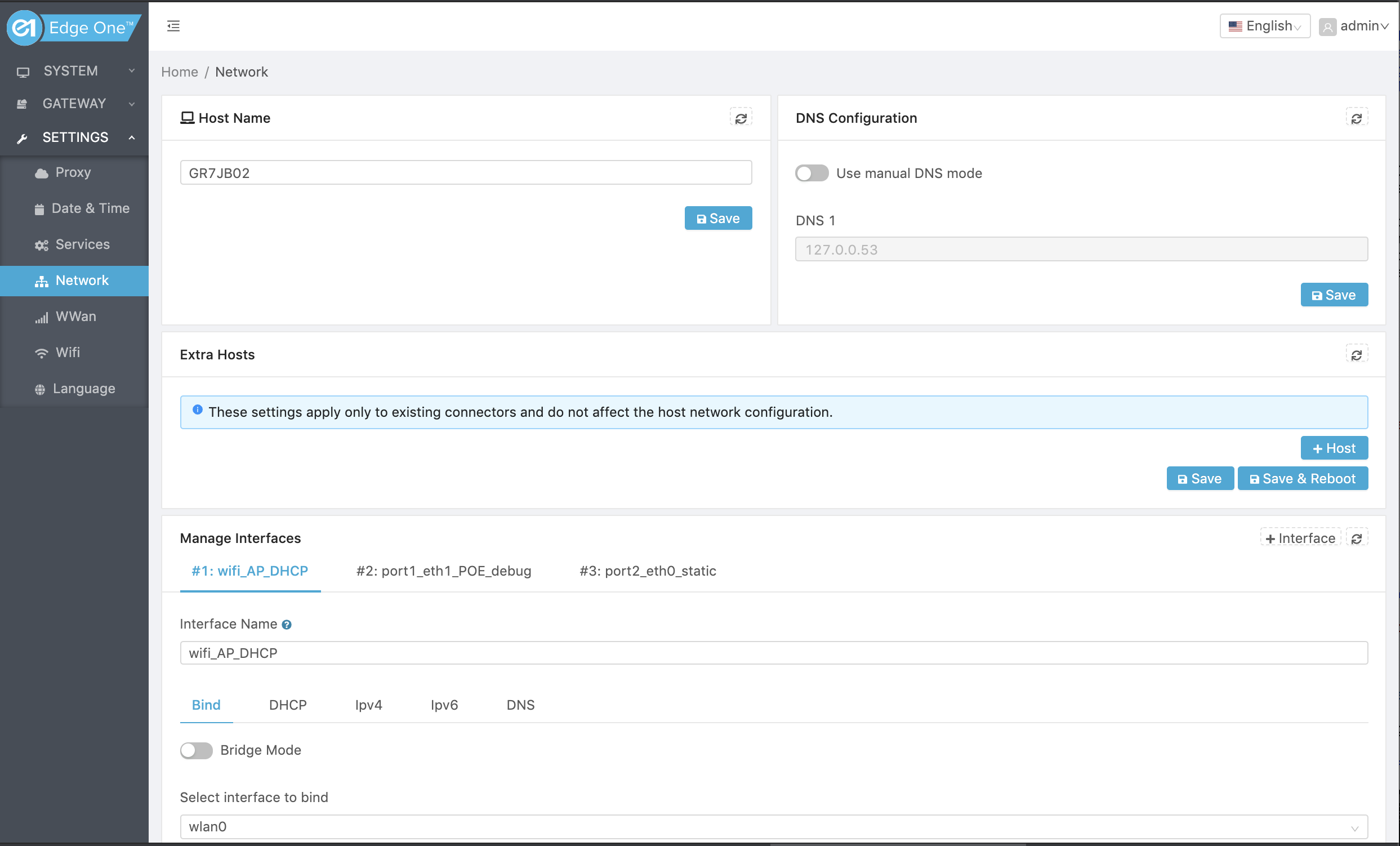
Host Name
To modify your Edge One™’s host name:
- Open the Network tab under Settings.
- Edit the host name in the Host Name panel.
- Click on Save to change the host name.

DNS Configuration
The DNS Configuration panel allows to view the current DNS configuration, add, modify, or delete DNS servers for Edge One™.
The default DNS configuration is to inherit the configuration from the operating system. To modify the DNS, turn ON the Use manual DNS mode switch.

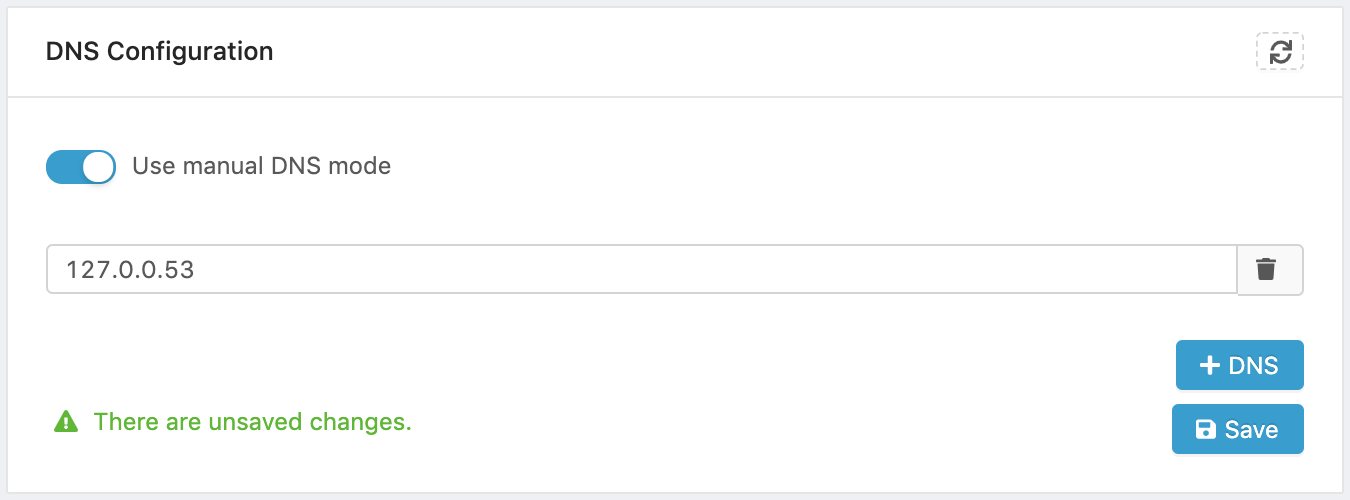
Add a DNS address
To Add a DNS address:
- Switch the Use manual DNS mode switch to ON. This enables the editing of the DNS host name and displays the Add DNS button.
- Click on DNS.
- Enter the IPv4 or IPv6 address of the new DNS server.
- Click on Save to store the new DNS host.
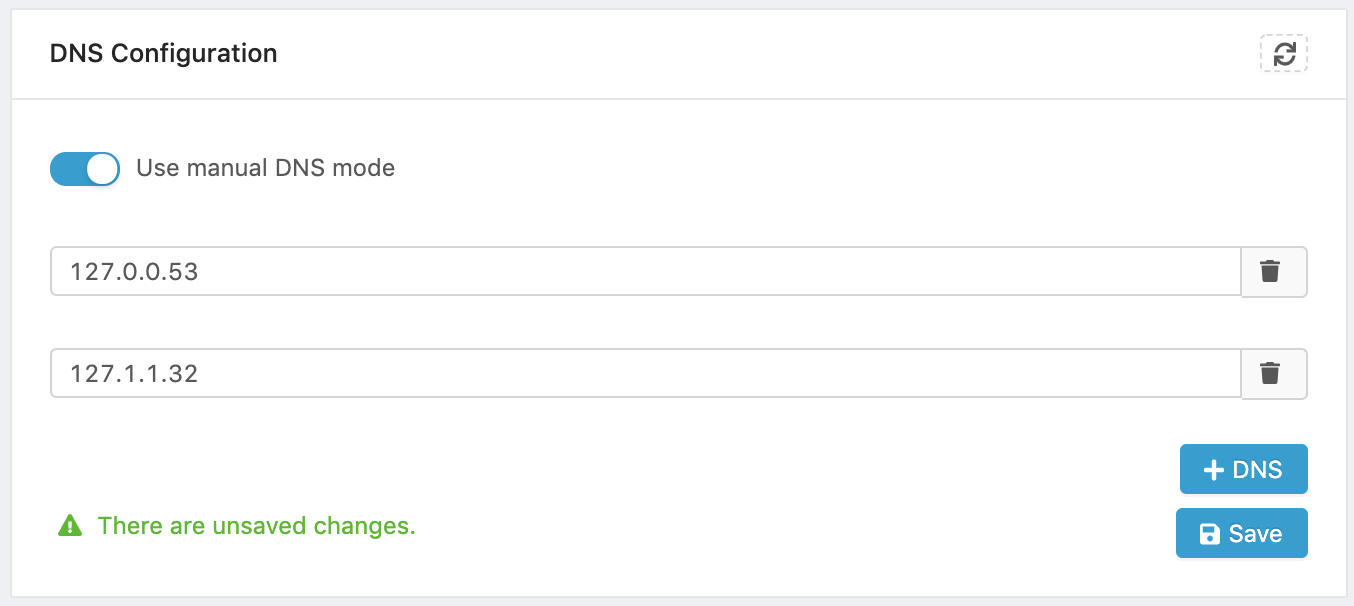
Modify a DNS address
To Modify a DNS address:
- Select the target DNS field from the DNS Configuration list.
- Enter the new DNS IP address on top of the old address.
- Click on Save.
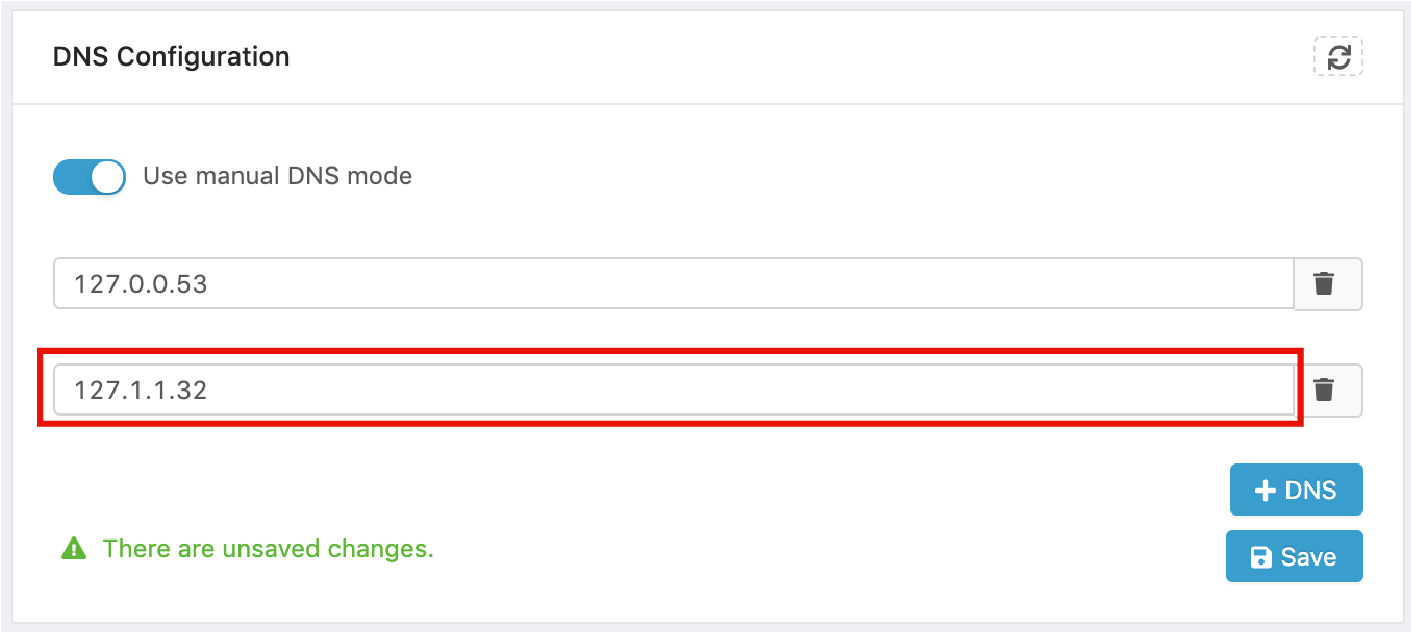
Delete a DNS address
To Delete a DNS address
- Click on the Delete button ( ) to the right of the address.
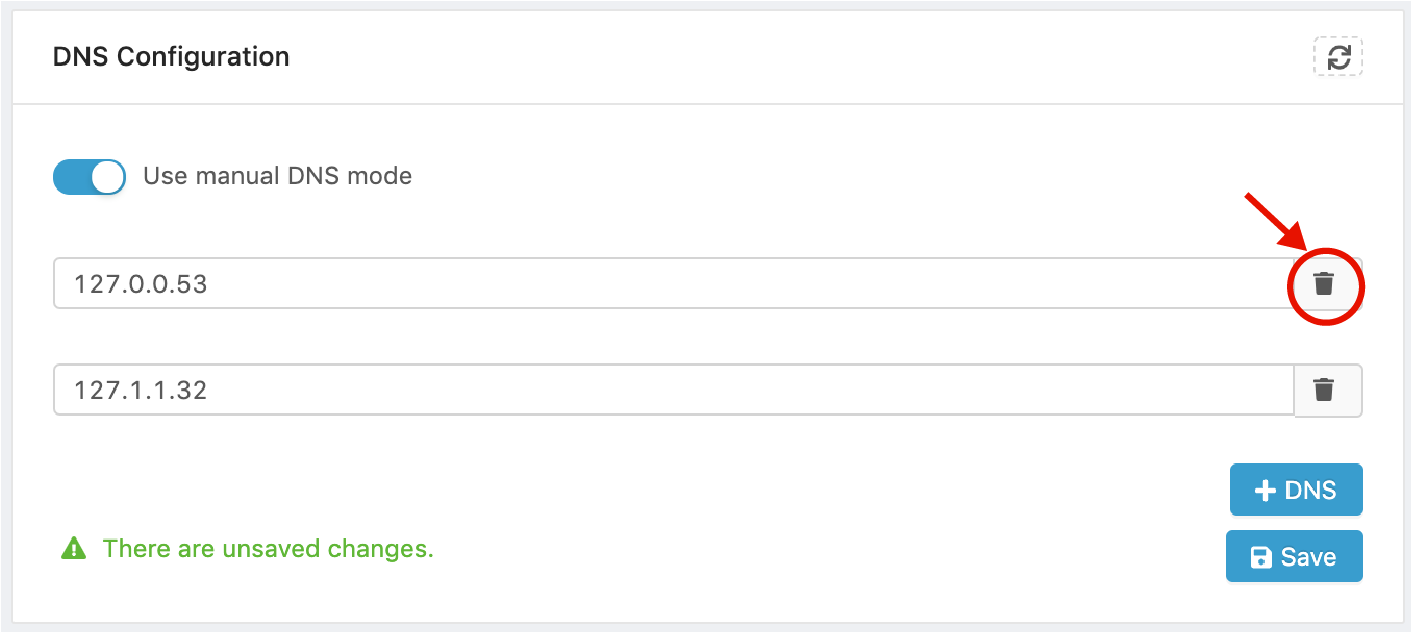
Extra Hosts
The Extra Hosts panel allows to add custom hosts that are made available to all the docker containers managed by Edge One™ without affecting the main Edge One™ host configuration.
This feature enables the additional host support option from Docker for its containers. The resulting list of hosts causes using the --add-host option in docker run multiple times.
For more information on the use of additional hosts on docker containers
refer to the Docker documentation.
To add new hosts:
- Click on ( ) Host in the Extra Hosts panel.
- Enter the host name and its IP address.
- Click on Save to save the configuration.

Manage Interfaces
The Manage Interfaces panel allows to:
- Add ( ) a new LAN, Wireless LAN, or WAN network interface.
- View or modify the available LAN, Wireless LAN and WAN interfaces.
Adding a New Network Interface
To add a new network interface:
- Click on ( ) Interface.
- Enter a name for the interface.
- Configure the interface as explained in the next subsection.
Configuring a Network Interface
Network interfaces have several parameters that can be accessed from their respective tabs and configured as needed:
- Bind or Bridge settings.
- DHCP settings.
- IPv4 settings. IPv4 settings are not visible when the interface is configured in DHCP Client mode since the IP address is received from the DHCP server.
- IPv6 settings. IPv6 settings are not visible when the interface is configured in DHCP Client mode since the IP address is received from the DHCP server.
- DNS settings.
Adding or modifying network interfaces requires that the host is rebooted with a Save and Restart before they take effect.
Each setting is explained in its own subsection below.
Bridging Settings
The Bind tab allows to bridge the selected interface with another network interface.
The default state is no bridging. To create a bridge:
- Open the Bind tab.
- Set Bridge mode switch to ON.
- Select the interface to bridge to from the dropdown menu.
- Then either:
- Save to save the setting and wait until the next Restart of Edge One™, or
- Save & Restart for the bridge to be enabled immediately.
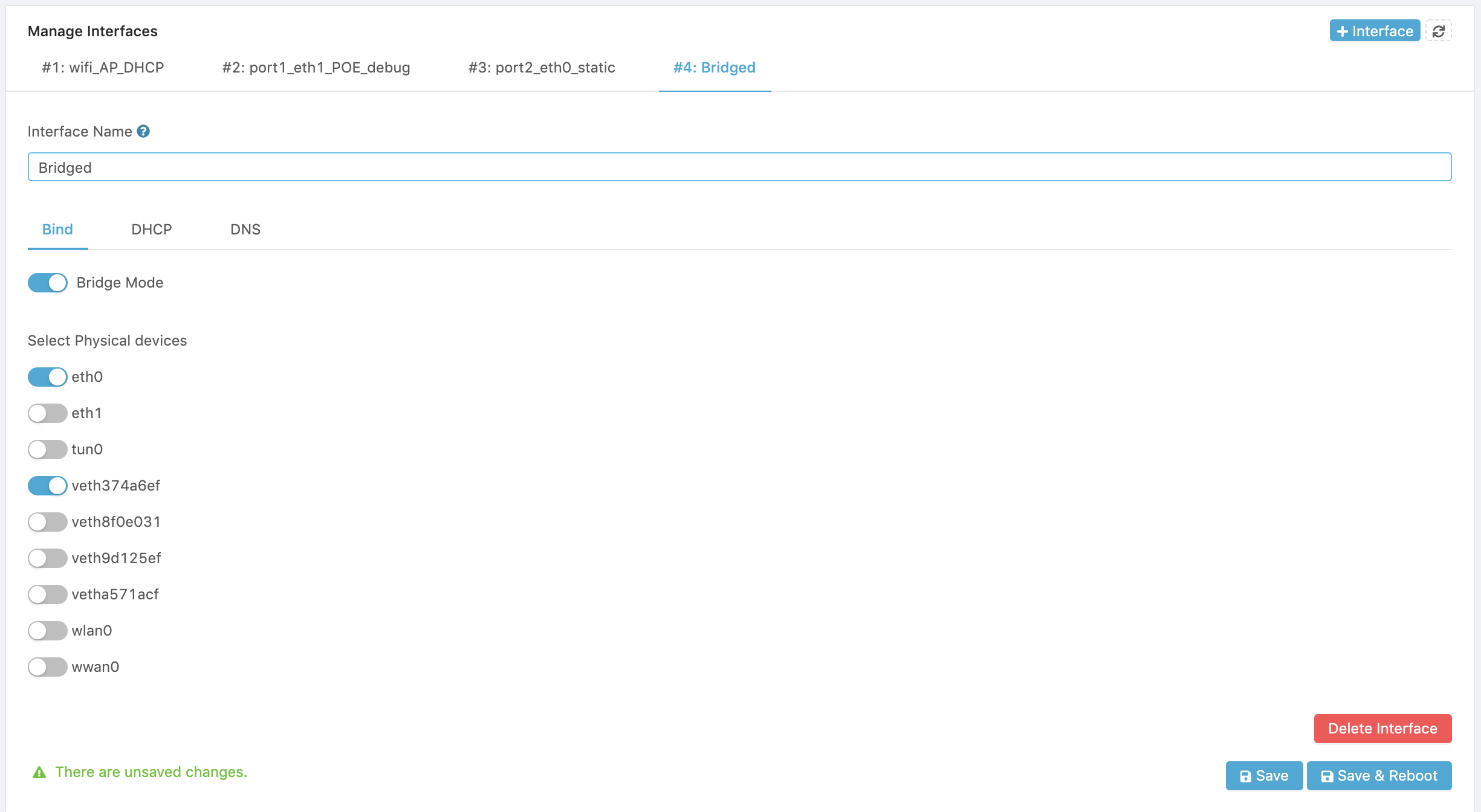
DHCP Settings
Dynamic Host Configuration Protocol (DHCP) is a client/server protocol that automatically provides an Internet Protocol (IP) host with its IP address and other related configuration information such as the subnet mask and default gateway.
Edge One™ can be configured in Static Mode with DHCP Off, as a DHCP Client or as a DHCP server.
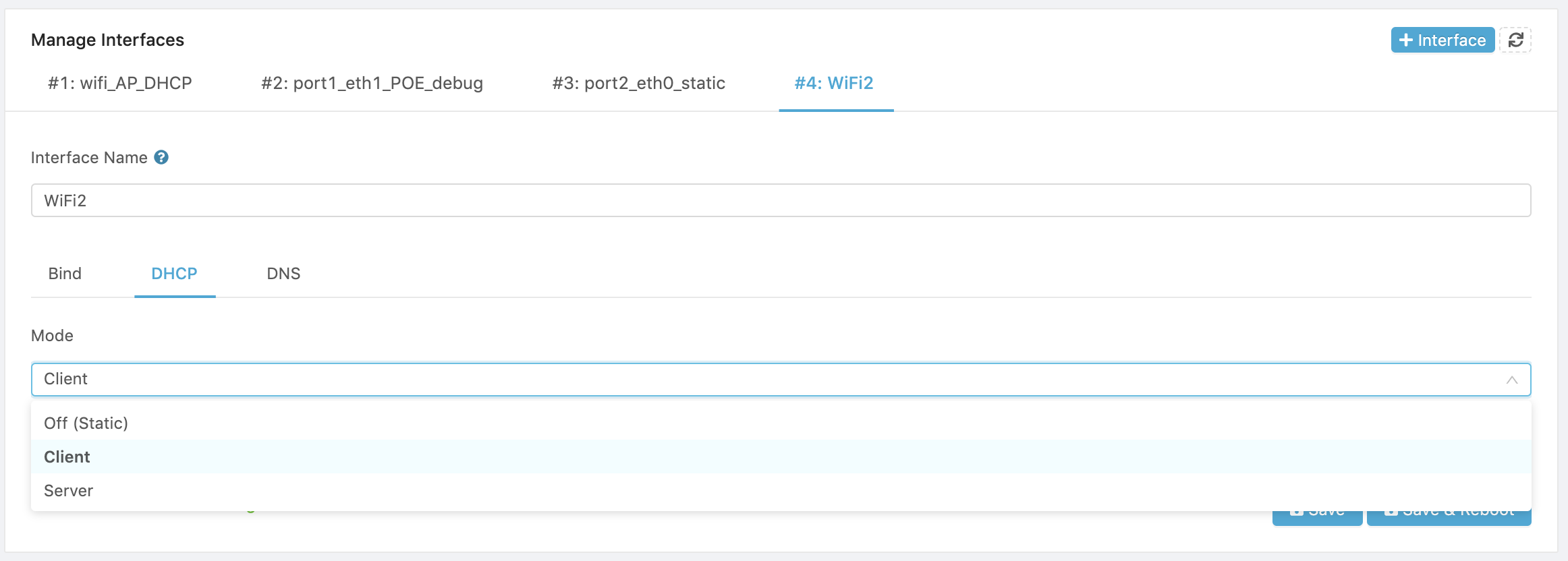
To configure the DHCP setting of Edge One™, select the DHCP tab and the configuration Mode.
-
Off (Static Mode) instructs Edge One™ to not look for a DHCP server to supply its IP address.
-
Client Mode instructs Edge One™ to lease an IP address from an available DHCP sever on the same network.
-
Server Mode sets Edge One™ as a DHCP server capable of leasing IP address to other network devices. It requires the configuration of the following parameters:
- Start IP address which is the first address that will be leased to a network device.
- End IP address determines the end address of the range of addresses that will be made available for leasing.
- Lease period (sec) indicates the time period in seconds for which the lease will be available before having to be renewed.
- DNS configures the IP address of the DNS server to use.
- Max Leases configures the maximum number of clients that can lease addresses from the server.
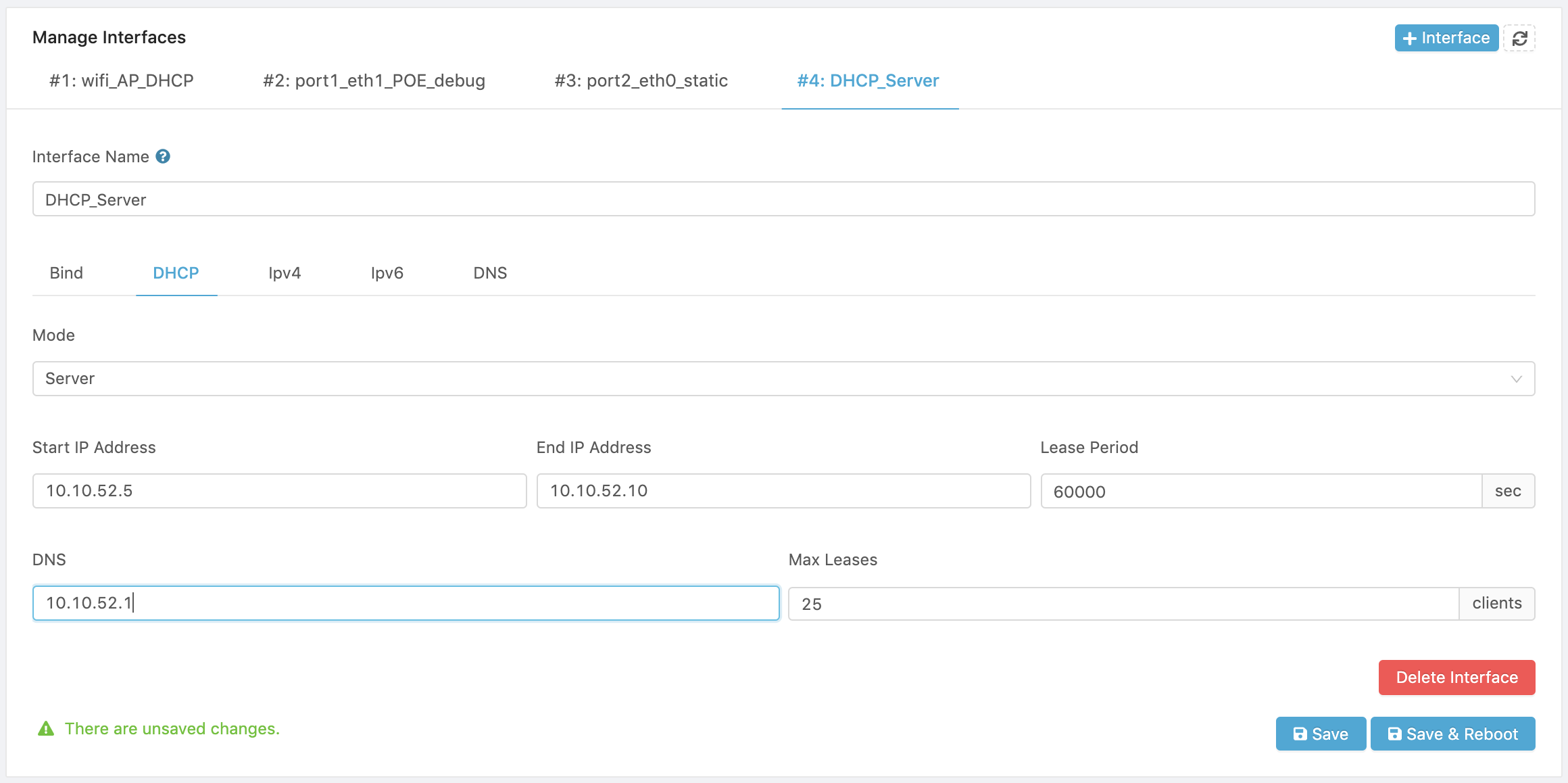
When clients connect, they are visible in the DHCP Clients panel.
IPv4 Settings
The IPv4 tab enables the setting of Edge One™’s IPv4 address. Internet Protocol version 4 (IPv4) is the fourth version of the Internet Protocol (IP) and the most commonly used. It defines an IP address as a 32-bit value.
IPv4 settings are not visible when the interface is configured in DHCP Client mode since the IP address is received from the DHCP server.
To set the IPv4 address of Edge One™:
- Select the IPv4 tab.
- Enter the IPv4 address.
- *Set the Netmask which can be Auto selected by the system, or one of the available netmasks in the dropdown menu.
- Optionally, enter the IPv4 address of the gateway that will provide Internet access.
- Optionally turn on the switch to Share WAN connection with this interface.
- Save the setting or Save and Restart to make the change take effect immediately.
Here are examples of IPv4 addresses:
192.168.1.100 8.8.8.8

IPv6 Settings
The IPv6 tab enables the setting of Edge One™’s IPv6 address. Internet Protocol version 6 (IPv6) is version 6 of the Internet Protocol (IP). It is becoming more widely used since it vastly enlarges the IP addresses space. IPv6 addresses have a size of 128 bits.
IPv6 settings are not visible when the interface is configured in DHCP Client mode since the IP address is received from the DHCP server.
To set the IPv6 address of Edge One™:
- Select the IPv6 tab.
- Enter the IPv6 address.
- *Set the Netmask which can be Auto selected by the system, or one of the available netmasks in the dropdown menu.
- Enter the IPv6 address of the gateway that will provide Internet access.
- Save the setting or Save and Restart to make the change take effect immediately.
Here are examples of IPv6 addresses:
2001:0db8:85a3:0000:0000:8a2e:0371:7335 2001:0db8:85a3:0000:0000:8a2e:: (the last two numbers are 0's and don't have to be explicitly written)
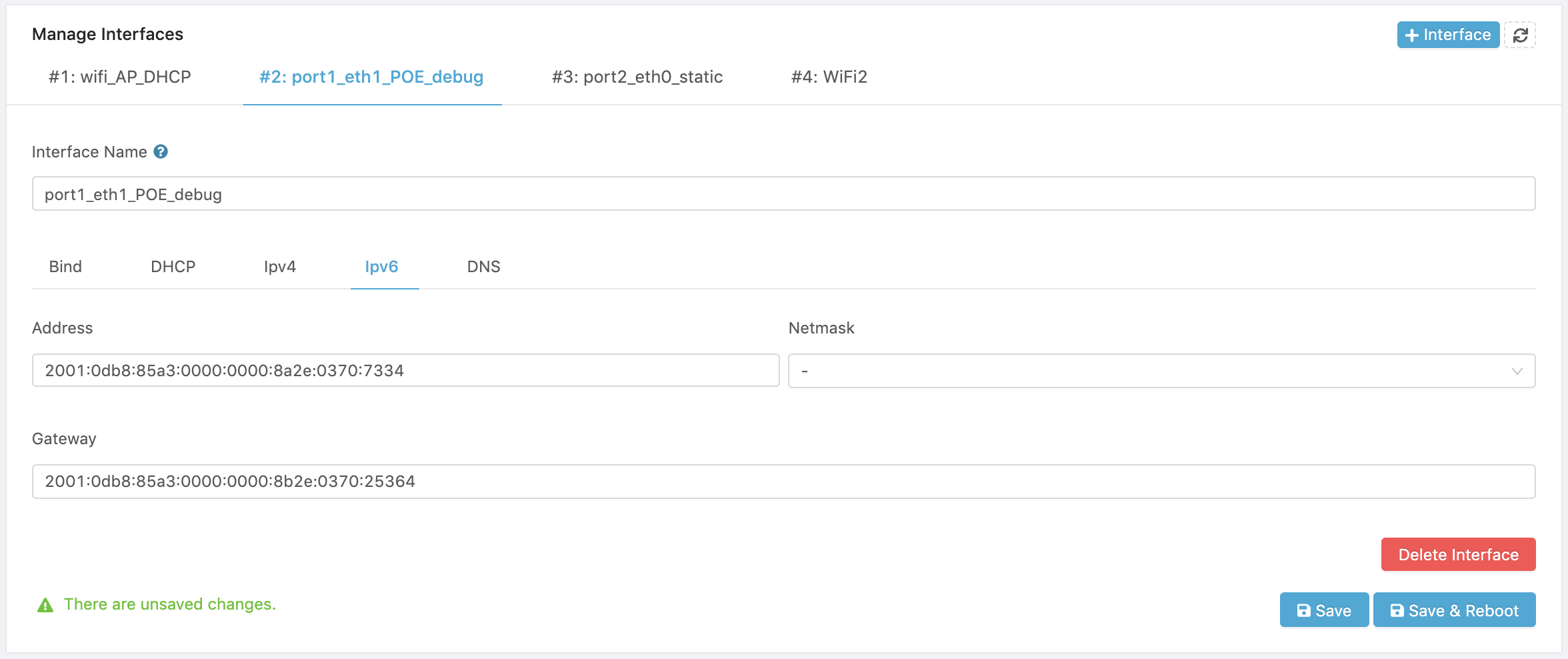
DNS Settings
The DNS tab is used to set or modify the Domain Name System (DNS) used by Edge One™ to resolve domain names and their Internet addresses.
To set the DNS(s) to be used:
- Select the DNS tab.
- Click on ( ) DNS to add a DNS server.
- Enter the IPv4 or IPv6 address of the DNS server.
- Save the setting or Save and Restart to make the change take effect immediately.
To add more DNS hosts click on ( ) DNS.
To delete a DNS host click on the ( ) button next to the IP address.
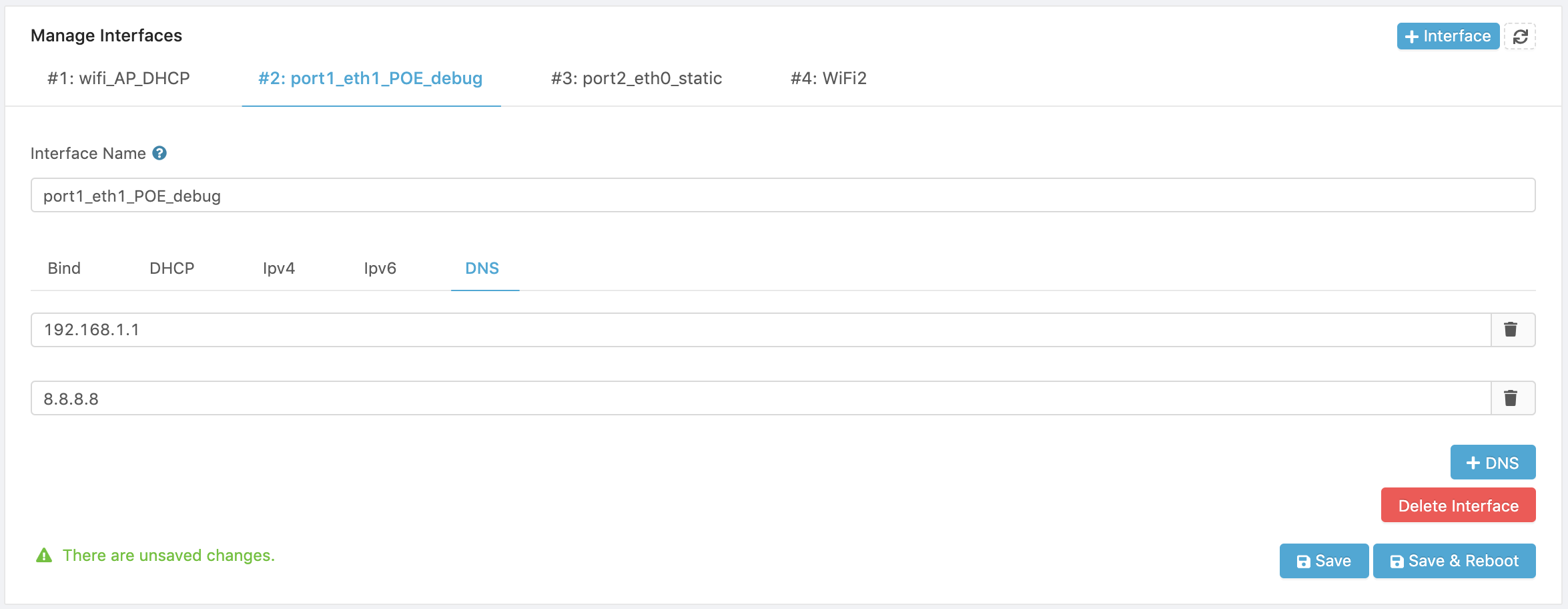
DHCP Clients
The DHCP Clients panel displays all the DHCP clients that Edge One™ has.
- MAC Address displays the MAC address or local network address of the client.
- Interface indicates teh interface through which the client is connected.
- IP address indicates the IP address assigned to the client.
- Host Name is the host name of the DHCP client.
- Lease Expiration displays the date and time when the client’s lease will expire.
The Refresh button ( ) refreshes the list and the information in it.

Interface Status
The Interface Status panel displays the status of several parameters of the interface(s) used by Edge One™.
- Interface indicates the name of the interface whose data is displayed in the columns to the left.
- Network indicates whether the interface is configured for LAN or WAN operation.
- Status indicates whether the interface is up, up, running or down.
- MAC is the MAC or local network address of the interface.
- TX displays the number of MB (MegaBytes) transmitted since the interface is active.
- RX displays the number of MB (MegaBytes) received since the interface is active.
- IPv4 displays the IPv4 address and netmask of the interface.
- IPv6 is the IPv6 address and netmask of the interface.
The Refresh button ( ) refreshes the list and the information in it.
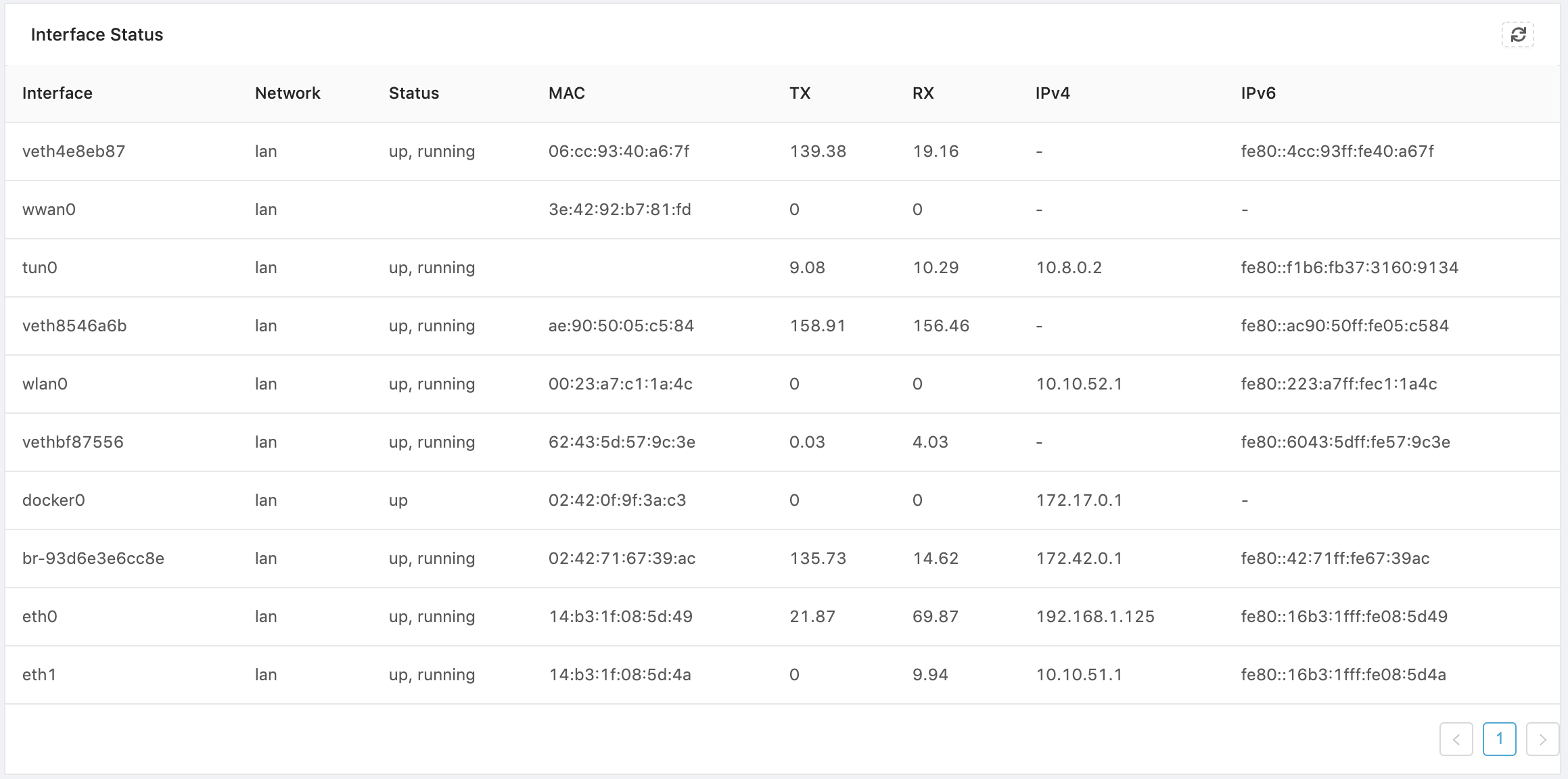
Connection List
The Connection List panel displays the current TCP connections of Edge One™. The following parameters are displayed:
- TCP State indicates if a TCP connection has been established.
- Source IP indicates the IP address of a network device sending packets to Edge One™.
- Source Port indicates the IP address port used by the device with the Source IP address.
- Destination Port indicates the IP address of the destination of the connection.
- Destination Port indicates the port of the destination of the connection.
- Actions allows to Force Kill a connection.
The Refresh button ( ) refreshes the list.
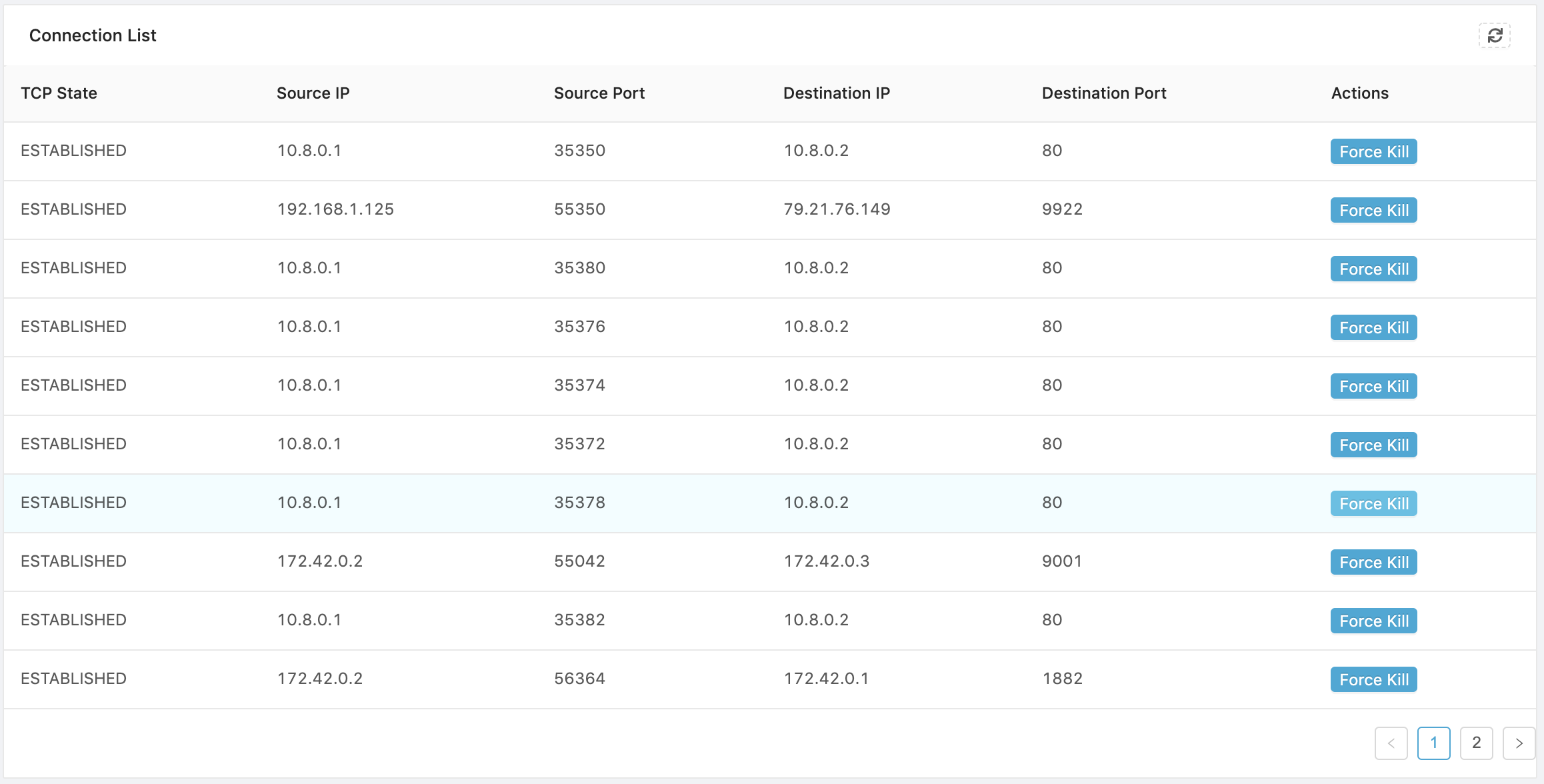
 CloudPlugs Edge One™ Platform 1.2.0 Documentation
CloudPlugs Edge One™ Platform 1.2.0 Documentation